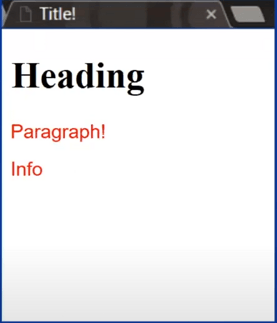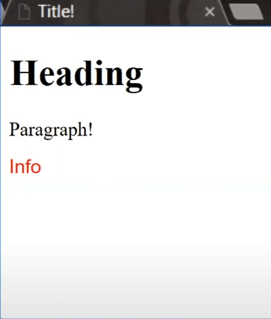MIT IAP 2021 Day 1 - HTML & CSS Lecture
前言
因为没有系统性的学习过前端,所以我的前端水平一直都是些三脚猫功夫,碰巧最近有几个月的完全空闲的时间,准备重新系统性地学习一下前端,为了尽可能快的掌握,我决定采用MIT IAP的课程,因为课程是英语讲授的,所以有关课程内容的的笔记我都会使用英文记录,以后的大部分笔记博文也以英文为主。
HTML
Definition
HTML stands for Hyper Text Markup Language. It's the language web browsers use to describe the structure and content of a web page.
In other words, HTML = Nested Boxes
Structure of Hello World!.html
A basic structure of HTML is as follows:
<!DOCTYPE html>
<html> # <- opening tag
<head>
<title>Title!</title>
</head>
<body>
<h1>Heading</h1>
<p>Paragraph</p>
</body>
</html> # <- closing tagHead tags(<head>) are used to describe the background information of the website, they can include the meta data of the website which can be used by search engine's spider.
The title element(<title>) is used to describe the title of the website, it will be displayed on the tab of the browser.
The body element(<body>) is used to describe the content of the website, it will be displayed on the main area of the browser.
Deeper in the body
The <h1> tag means the heading element, it's the highest priority heading on this page.
The <p> tag means the paragraph element, it's used to describe the paragraph of the website.
Basic HTML Tags
| Tags | Meanings |
|---|---|
<html> |
Root of HTML Document |
<head> |
Info about Document |
<body> |
Document Body |
<h1>,<h2>,<h3>,… |
Header Tags |
<p> |
Paragraph tag |
<div> |
Generic block section tag |
HTML Attributes
<tagname abc="xyz"> # <- opening tag
# content goes here
</tagname> # <- closing tagabc is the attribute name, xyz is the attribute value.
Eaxamples
Inserting Links
The first example is inserting links.
<a href="link here">
#content goes here
</a>href is the attribute name, link here is the attribute value.
Inserting Images
<img src="yoda.gif"></img>or, we can create a self-closing tag:
<img src="yoda.gif" />The file structure should look like this:
app/
hello.html
yoda.gifThe image should be in the same level folder as the html file.
If more orginaized, we can create a folder called images and put all the images in it.
app/
hello.html
images/
yoda.gifThen we can use the following code to insert the image:
<img src="images/yoda.gif" />Div
Back to the example of Hello World!.html, we can use the <div> tag to wrap the <h1> and <p> tags, so we can give them same attribute without adding them one by one.
<div>
<h1>Heading</h1>
<p>Paragraph</p>
</div>There are a lot of tags in html.
The real way to learn Web Dev is
- Learn
Also, we can check on MDN for more information.
We can find a lot of information about html and css on MDN.
Don't recommend W3Schools(out of date).
Why not just use <div>?
The accessibility will be affected.
If you visit <div> on mdn, you will find



They don't have any semantic meaning.
There might be better options.
Why Semantics?
Benefits for:
- Screen Readers
- KeyBoard Navigation
- Machine Readable/friendly to web crawlers(make your website more discoverable)
- Human Readable(easier to maintain)
CSS
What is CSS?
CSS means Cascading Style Sheets.
It's the rules that tell your browser how stuff looks.
CSS = A list of discriptions
aka making things look pretty.
CSS ruleset
div {
color: red;
font-family: Arial;
font-size: 24pt;
}div in the very beginning is the selector, it tells the browser to apply the following rules to all the <div> tags.
In the list, color, font-family, font-size are the properties, red, Arial, 24pt are the values.
For example
<h1>Heading!</h1>
<div>Paragraph!</div>
<div>Info</div>div {
color: red;
font-family: Arial;
font-size: 24pt;
}
or we can set a class, we shoud add a class attribute to the <div> tag, and we should change the selector name.
<h1>Heading!</h1>
<div>Paragraph!</div>
<div class="info">Info</div>.info {
color: red;
font-family: Arial;
font-size: 24pt;
}
if use id
<h1>Heading!</h1>
<div>Paragraph!</div>
<div id="info">Info</div>#info {
color: red;
font-family: Arial;
font-size: 24pt;
}The effect is the same as using class.
ID vs Class
| ID | Class |
|---|---|
| An element can have only one ID | An element cna have multiple classes |
| IDs must be unique in any given HTML document | Can use the same class on multiple elements |
Important Concept!
Tags such as <h1> have some default styling while <div> and <span> do not.
Any custom applied CSS will override the default styling.
Combining HTML and CSS
<!DOCTYPE html>
<html>
<head>
<title>Title!</title>
<link rel="stylesheet" href="style.css" />
</head>
<body>
<h1>Heading</h1>
<p>Paragraph</p>
</body>
</html>In Conclusion
HTML = nested boxes
CSS = a list of descriptions
A description in the CSS affects a box in the HTML.


Comments NOTHING